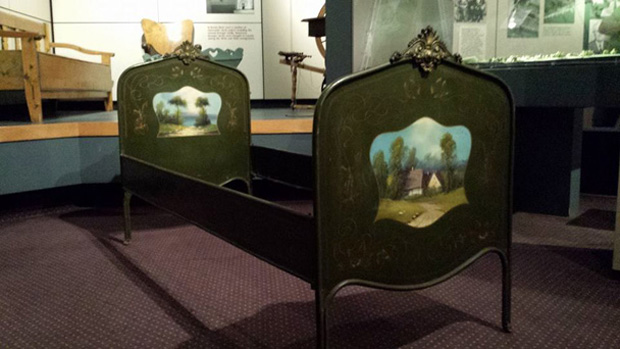Food, blankets, tools and clothing; whatever one could carry. In the confusion and danger of the Russian Revolution in 1917 and the civil war that followed, many Mennonite families were forced to leave everything behind so that they might escape and immigrate to Canada. Astonishingly, some family treasures made it too – porcelain and Kroeger clocks, for example, and, in the case of one of the most recent artifacts to join the Museum’s collection, a child’s bed frame, donated by Hugo Unruh. Two meters long and made of metal, it was no small thing for refugees to bring with them.
This bed frame belonged to the donor’s grandmother, Helena Unruh, born in 1900, in Russia. She grew up in Barwenkowa, a town of about 30,000 with a railroad station, six steam-powered grist mills, and a Kommerzschule (business school), which she and two of her brothers attended. Helena’s father, David Heinrich Unruh, was a successful businessman and her family lived in a brick house on a large property near the train station. Following the start of the Second World War in 1914, things changed drastically for Helena and her family. In the midst of the violence and chaos of the Revolution, the police in Barwenkowa lost all authority and groups of bandits, led by Nestor Makhno, swept through the countryside. It was too risky to stay.
In 1918 they left everything behind and moved to Muntau, near Neu Halbstadt in the Molotschna Colony. Violence was commonplace and conditions were desperate. The family moved several times and was divided when the sons ‘disappeared’ to escape conscription. The situation worsened when a severe famine overtook Ukraine and Helena’s parents traded their gold wedding rings, the only items of value they had left by that time, for food. The family was reunited in Neu Halbstadt after the war and by this time Helena had married Nicolai Unruh.
In the 1920s, as part of an effort to alleviate the suffering among Mennonites in the Soviet Union, North American Mennonites made arrangements for Russian Mennonites to immigrate to Canada. This included an arrangement with the Canadian Pacific Railway that would grant Mennonite refugees loans to cover the costs of the trip to Canada. In 1922, Helena, Nicolai, and their six-month old child, Elfriede, immigrated to Canada under this arrangement.
Throughout the years of the Unruh family’s flight, this little metal bed, along with another like it that belonged to Helena’s brother, travelled with them, wrapped in its felt mattress for protection. Helena’s childhood bed became a family heirloom, passed down and used by children through the generations. The bed, and specifically the unique hand-painted scenes on the head- and foot-boards, is in excellent condition. Considering the miles it has travelled, the conditions under which these journeys were made, and the generations of children who have rested in it, this is a remarkable artifact indeed and we are privileged to care for it as part of the collection at the Mennonite Heritage Village.
The bed-frame was factory made in Russia and the hand painting would have been done in this setting as well. Pastoral scenes, flowers, etc. were decorative, and reflected a common motif in the late nineteenth century – romanticisation of rural life. The donor would not find deeper meaning in the paintings, rather sentimental attachment to the object and perhaps what it represented; a happy childhood and life that was lost in the revolution.




